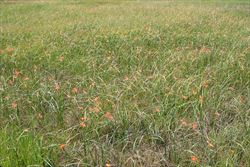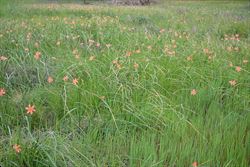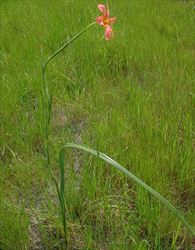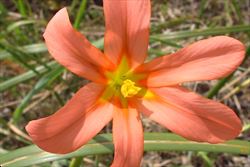Click on images to enlarge

large infestation (Photo: Sheldon Navie)

infestation (Photo: Sheldon Navie)

habit (Photo: Sheldon Navie)

habit of plant showing the single large strap-like leaf (Photo: Sheldon Navie)

stems and leaves (Photo: Sheldon Navie)

flowers (Photo: Sheldon Navie)

close-up of flower showing yellow centre and stamens (Photo: Sheldon Navie)
Scientific Name
Moraea flaccida (Sweet) Steud.
Synonyms
Homeria breyniana G.J. Lewis (misapplied)Homeria breyniana G.J. Lewis var. aurantiaca (Sweet) G.J. Lewis (misapplied)Homeria collina Salisb. (misapplied)Homeria collina Salisb. var. miniata-minor Ker Gawl.Homeria flaccida Sweet
Family
Iridaceae
Common Names
Cape tulip, one leaf Cape tulip, one-leaf Cape tulip, one-leaved Cape tulip
Origin
Native to southern Africa (i.e. Cape Province in South Africa).
Cultivation
Like many other species in this genus, one-leaf Cape tulip (Moraea flaccida) has been widely cultivated as a garden ornamental in the temperate regions of Australia.
Naturalised Distribution
Widely naturalised in southern Australia (i.e. naturalised in some parts of eastern New South Wales, in Victoria and Tasmania, in south-eastern and southern South Australia and in south-western Western Australia). Also naturalised on Norfolk Island.
Habitat
A common weed of pastures, open woodlands, grasslands, wetland margins, roadsides, parks, disturbed sites, waste areas and crops in temperate regions. It may occasionally also be found in semi-arid regions.
Habit
An upright (i.e. erect) herbaceous plant with long-lived (i.e. perennial) underground 'bulbs' (i.e. corms) and short-lived (i.e. annual) stems and leaves. This species usually grows 25-60 cm tall, but it may sometimes reach up to 75 cm in height.
Distinguishing Features
- an upright herbaceous plant with short-lived stems (25-60 cm tall) growing each year from a long-lived underground 'bulb'.
- each plant produces a single large strap-like leaf (up to 1 m long and 6-20 mm wide) which sheath the base of the stem.
- its flowers are usually orange or salmon pink in colour, with yellow centres, and have six elongated 'petals' (25-40 mm long).
- its fruit is an elongated capsule (25-55 mm long) that has a short projection at its tip (2-3 mm long).
Stems and Leaves
The green stems are upright (i.e. erect) and sometimes slightly zig-zagging in nature. These stems are rounded, hairless (i.e. glabrous), and produce a few branches near the top of the plant.
There is usually only one large leaf per plant, and this leaf sheaths the lower part of the stem. It is strap-like (i.e. linear), hairless (i.e. glabrous), slightly ribbed and folded when young (up to 1 m long and 6-20 mm wide). There are also some smaller leafy bracts (2-6 cm long) towards the top of the stems.
Flowers and Fruit
The flowers (3-8 cm across) are borne at the tips of the branches and have six elongated 'petals' (i.e. tepals or perianth segments) 25-40 mm long. They are usually orange or salmon pink in colour with a yellow centre, but they can occasionally be entirely yellow with a slightly darker centre. At the base of each flower are two elongated green floral bracts (3-8 cm long) which may be mistaken for sepals. Each flower also has three stamens with yellow anthers (8-11 mm long) and an ovary topped with a three-branched style. Flowering occurs mostly during late winter and early spring (i.e. from August to October).
The fruit is a green capsule that turns brown in colour as it matures. This capsule is elongated in shape (25-55 mm long), has a short projection (i.e. beak) at its tip (2-3 mm long), and contains up to 150 small seeds. The seeds are brown in colour and irregularly shaped (about 2 mm long) with slightly winged margins.
Reproduction and Dispersal
This species reproduces vegetatively by 'bulbs' (i.e. corms) and also produces seed. Mature corms (10-25 mm across) are white, with a light brown fibrous covering, and produce 1-3 new corms each season.
The corms and seeds are both spread by machinery and in contaminated agricultural produce. Seeds may also be dispersed by animals, wind and water, and corms dispersed during the cultivation of paddocks.
Environmental Impact
One-leaf Cape tulip (Moraea flaccida) is regarded as a significant environmental weed in Victoria, South Australia and Western Australia, and as an environmental weed in New South Wales and Tasmania. This species is actively managed by community groups in Western Australia, and was recently listed as a priority environmental weed in at least one Natural Resource Management region.
Other Impacts
Legislation
This species is declared under legislation in the following states and territories:
- New South Wales: Class 4 - a locally controlled weed. The growth and spread of this species must be controlled according to the measures specified in a management plan published by the local control authority and the plant may not be sold, propagated or knowingly distributed (in a minority of local authority areas). See the New South Wales Department of Primary Industries Noxious Weeds List at http://www.dpi.nsw.gov.au for more detailed information on which local areas are covered in these declarations. This declaration includes all Cape tulip species (Moraea spp.).
- South Australia: 2n@ - this species is regarded as a Class 2f weed and its control is required in part of the state only.
- Tasmania: D - the importation or sale of this species is prohibited and measures to reduce its population in an area, eradicate it from an area, or restrict it to a particular area may be required.
- Victoria: P8 - prohibited and must be eradicated or controlled (in the Mallee, Corangamite, Port Phillip East, Goulburn, North East, West Gippsland and East Gippsland regions and all parts of the Wimmera region except the West Wimmera local authority area), and C3 - all reasonable steps must be taken to control the weed and prevent its spread (in the Glenelg, North Central and Port Phillip West regions and also in the West Wimmera local authority area of the Wimmera region).
- Western Australia: P1 - the movement of this species or its seeds is prohibited (throughout the entire state), P3 - a weed which cannot be eradicated in the short term, but must be kept under 'control' (in some parts of the state), and P4 - it must be 'contained' (in some parts of the state). See the Western Australian Department of Agriculture and Food Declared Plant List at http://www.agric.wa.gov.au/ for more detailed information about which areas are covered by these declarations.
Management
For information on the management of this species see the following resources:
- the Victorian Department of Primary Industries Landcare Note on this species, which is available online at http://www.dpi.vic.gov.au.
- the Western Australian Department of Agriculture and Food Farmnotes on Cape tulips, which are both available online at http://www.agric.wa.gov.au.
Similar Species
One-leaf Cape tulip (Moraea flaccida) is similar to Cape tulip (Moraea collina), two-leaf Cape tulip (Moraea miniata) and Cape tulip (Moraea ochroleuca). These species can be distinguished by the following differences:
- one-leaf Cape tulip (Moraea flaccida) has a single large leaf and usually has orange or salmon pink (rarely yellow) flowers with elongated petals (30-40 mm long). It is a relatively large plant, often up to 60 cm or more tall, and does not produce small bulb-like structures (i.e. cormils) in its leaf forks (i.e. axils).
- Cape tulip (Moraea collina) has a single large leaf and usually has pale yellow or salmon pink flowers with elongated petals (13-23 mm long). It is a relatively small plant, usually less than 35 cm tall, and does not produce small bulb-like structures (i.e. cormils) in its leaf forks (i.e. axils).
- two-leaf Cape tulip (Moraea miniata) has two or three large leaves and usually has salmon pink or orange flowers with relatively broad petals (13-25 mm long). It is a relatively large plant, usually 30-60 cm tall, and produces small bulb-like structures (i.e. cormils) in its leaf forks (i.e. axils).
- Cape tulip (Moraea ochroleuca) has a single large leaf and usually has yellow (rarely orange) flowers with relatively broad petals (30-40 mm long). It is a relatively large plant, usually 40-70 cm tall, and does not produce small bulb-like structures (i.e. cormils) in the leaf forks (i.e. axils).
In Australia, the difference between one-leaf Cape tulip (Moraea flaccida) and Cape tulip (Moraea collina ) is somewhat blurred. Naturalised populations in this country are derived from cultivated plants which sometimes involved complex hybrids of the two species. Hence, some populations can be identified as belonging to one of the two species, while others are intermediate between them.

